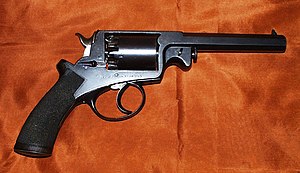Beaumont–Adams
| Beaumont–Adams revolver | |
|---|---|

Beaumont–Adams percussion revolver
|
|
| Type | Service revolver |
| Place of origin | United Kingdom of Great Britain and Ireland |
| Service history | |
| In service | 1862–1880 |
| Used by |
United Kingdom & Colonies British Commonwealth Royal Canadian Mounted Police United States Confederate States |
| Wars |
American Civil War Anglo-Zulu War First Boer War numerous British colonial conflicts |
| Production history | |
| Designer | Lt. Beaumont (Royal Engineers), Robert Adams |
| Designed | 1862 |
| Manufacturer | Robert Adams of London |
| Produced | 1862–1880 |
| No. built | c. 250,000 |
| Specifications | |
| Weight | 2.4 lb (1.1 kg), unloaded |
| Length | 11.25 in. (286 mm) |
|
|
|
| Cartridge | Cap & Ball |
| Calibre | .479 (38-bore), .442 (54-bore), & .338 (120-bore) |
| Action | Double-action revolver |
| Rate of fire | 12 rounds/minute |
| Muzzle velocity | 620 ft/s (190 m/s) |
| Effective firing range | 35 yds |
| Maximum firing range | 100 yds |
| Feed system | 5-round cylinder |
| Sights | fixed front post and rear notch |
The Beaumont–Adams revolver is a muzzle-loading, double-action, percussion revolver. Originally adopted by the British Army in .442 calibre (54-bore, 11.2mm) in 1856, many were later converted to use centrefire cartridges. It was replaced in British service in 1880 by the .476 calibre (actually 11.6mm)Enfield Mk I revolver.
On 20 February 1856, Lieutenant Frederick E. B. Beaumont of the Royal Engineers was granted a British patent for improvements to the Adams revolver which allowed them to be cocked and fired either by manually cocking the hammer as in Colt single-action revolvers, or by just pulling the trigger. Beaumont was granted a US Patent (no. 15,032) on 3 June of the same year.
At that time there was intense competition between Adams and Colt, which was rapidly expanding its sales and had opened a London factory competing with the British firearms trade, manufacturing firearms with interchangeable parts. The older 1851 and 1854 Adams revolvers were self-cocking, also known as double-action. The Adams revolver was favoured by British officers in the Crimean War and colonial conflicts due to the stopping power of its larger 54 bore (.442 cal) bullet (compared with their main competitor, the smaller .36 cal Colt Navy revolvers), and the speed of the Adams trigger-cocking action for close-quarters fighting (over the more cumbersome Colt action).
In partnership with George and John Deane, the company of Deane, Adams & Deane produced the new revolver in a variety of calibres and sizes, from pocket pistols to large military versions. The United Kingdom officially adopted the 54-bore (.442 calibre) Beaumont–Adams in 1856, Holland and Russia following soon after. To meet the growing demand for its weapons, Deane, Adams & Deane contracted companies in Birmingham and Liége to manufacture their weapons under licence. The new revolver gave Robert Adams a strong competitive advantage and Samuel Colt shut his London factory due to a drop in sales.
...
Wikipedia
